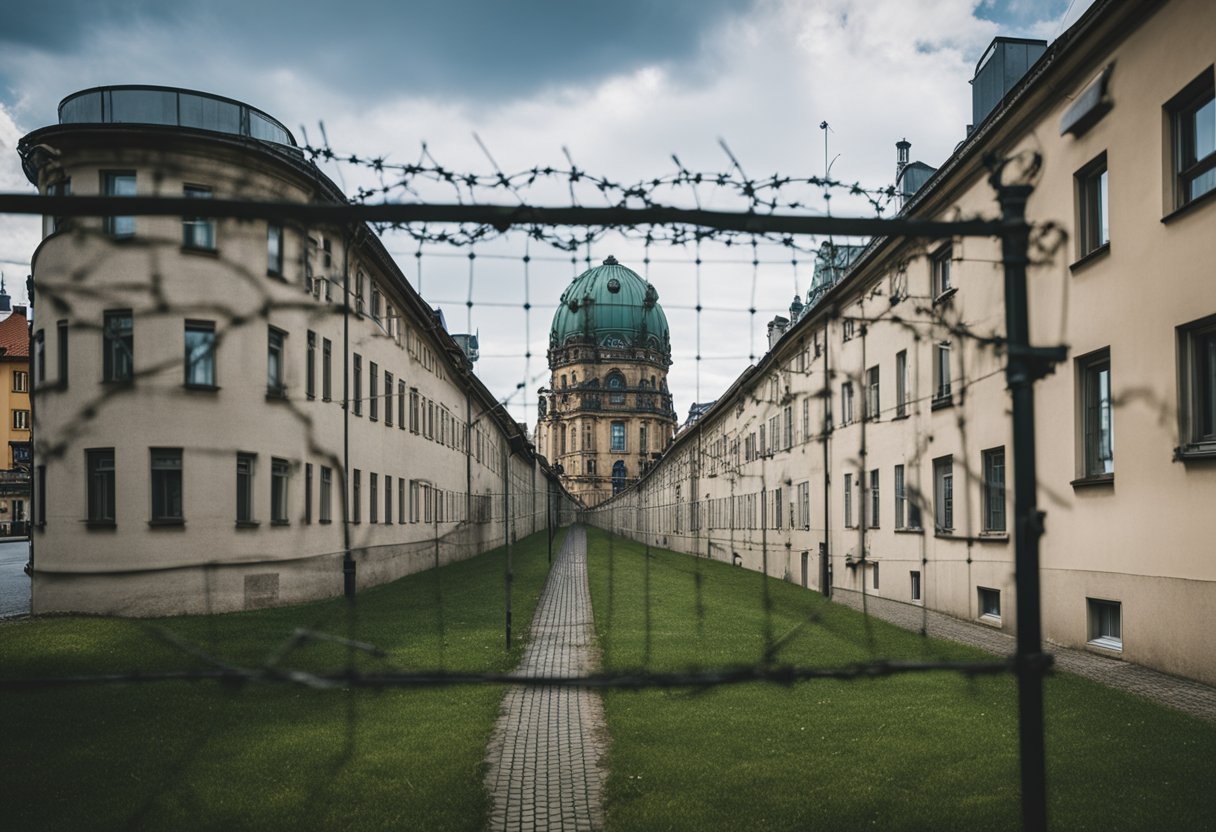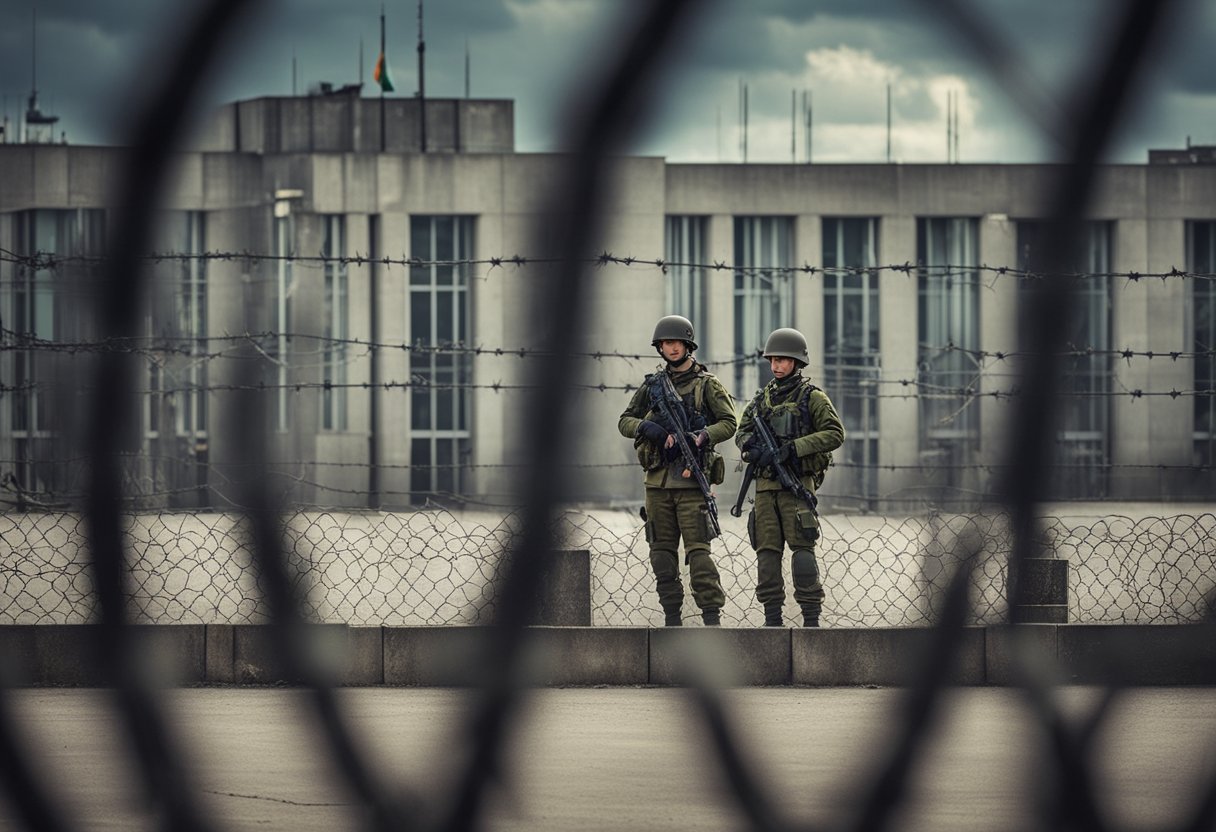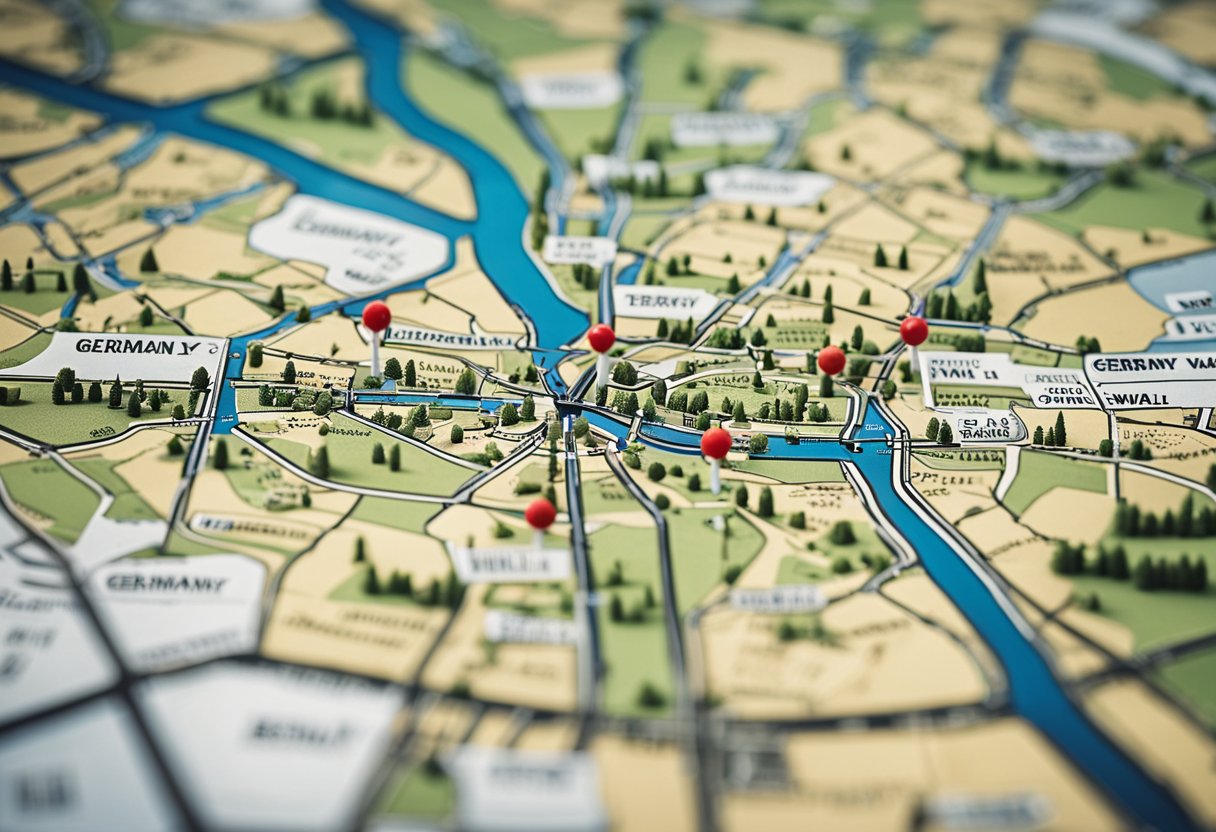Following the conclusion of World War II, Germany and Berlin’s Post-War Division, faced a significant geopolitical realignment. The country was devastated by the war, which left the Allies with the task of rebuilding and administering the territory.
Germany was divided into four occupation zones, each controlled by one of the main Allied powers: the United States, the United Kingdom, France, and the Soviet Union.
This division was a result of agreements made during wartime conferences, where the Allies planned for a post-Nazi Germany and aimed to diminish German power to ensure peace.

Berlin, located deep within the Soviet zone, was itself split into four sectors mirroring the division of the larger country.
The four-power occupation of both Germany and Berlin was established at the Potsdam Conference, emphasizing the country’s demilitarization, denazification, democratization, and decentralization.
Despite initial intentions for cooperative governance, ideological differences led to increasing tensions between the Soviet Union and the Western Allies, setting the stage for the Cold War.
The separation evolved into a more permanent division with the establishment of the Federal Republic of Germany (West Germany) and the German Democratic Republic (East Germany) in 1949.
In Berlin, the tension crystallized physically in 1961 with the construction of the Berlin Wall, which stood as a stark symbol of the Cold War and the division between East and West.
This bifurcation was emblematic of the broader global divide and lasted until the eventual fall of the Berlin Wall in 1989, leading to the reunification of Germany in 1990.
Historical Background

The separation of Germany and its capital, Berlin, into occupation zones by the victorious Allied powers marked the beginning of a divided nation that would last until the end of the Cold War.
Germany and Berlin’s Post-War Division
End of World War II and Beginning of Occupation
When World War II reached its conclusion, Germany found itself defeated and its territories occupied by the Allied Powers, including the Soviet Union, United States, United Kingdom, and France.
The Allied Control Council was established to oversee the administration of Germany as a whole, but the country was subsequently divided into four separate occupation zones to manage the varying interests and political ideologies of the occupying forces.
Potsdam Conference and Division of Germany
It was at the Potsdam Conference where the fate of post-war Germany was formally decided. Here, the leaders of the United States, Soviet Union, and the United Kingdom delineated the borders that would partition Germany and Berlin into four zones.
Each of these zones was to be controlled by an Allied nation, aiming to demilitarize, denazify, democratize, and decentralize Germany. Berlin, the capital, even though situated within the Soviet zone, was itself subdivided into four sectors to underscore the quadripartite rule.
This arrangement laid the groundwork for the subsequent political, economic, and social division of Germany and its capital.
Creation of East and West Germany

Following the defeat of Nazi Germany in World War II, the victorious Allied powers divided the country into four occupation zones.
This partition laid the groundwork for the eventual emergence of two separate German states: the Federal Republic of Germany (West Germany) and the German Democratic Republic (East Germany).
Formation of the German Democratic Republic
The German Democratic Republic (GDR), commonly known as East Germany, was established on October 7, 1949. East Germany was formed from the Soviet occupation zone and quickly adopted a Communist government.
This new state was molded by socialist principles in stark contrast to the capitalist West. The GDR claimed Berlin as its capital, although Berlin itself was divided and its eastern part became the de facto capital of East Germany. The government nationalized industry and initiated plans for socialist-style reconstruction.
Formation of the Federal Republic of Germany
In response to the developments in the Soviet zone, the Western Allies – France, the United Kingdom, and the United States – merged their respective zones to form the Federal Republic of Germany, or West Germany, on May 23, 1949.
West Germany was formed as a democratic state with a capitalist economic system. The new government introduced the Deutsche Mark to stabilize the economy. Though Berlin was located in the Soviet sector, West Germany positioned its capital in Bonn, with West Berlin being a special political entity linked to the Federal Republic.
The Division of Berlin

After World War II, Berlin was a focal point of geopolitical tension that symbolized the broader Cold War divisions. The city was split into four sectors, each administered by a different Allied power, and it became the epicenter of confrontation between the Western Bloc and the Soviet Union.
Berlin’s Four Sectors
Berlin, located deep within the Soviet Zone, was subdivided into four sectors, which were controlled by the major Allied powers: the United States, the United Kingdom, France, and the Soviet Union. The American, British, and French sectors combined to form West Berlin, while the Soviet sector became known as East Berlin.
- U.S. Sector: Comprised areas of the American administrative presence.
- British Sector: Included regions overseen by British forces.
- French Sector: Consisted of parts controlled by France.
These divisions laid the groundwork for the city’s future as a divided metropolis, with contrasting political ideologies shaping each sector.
The Berlin Blockade and Airlift
In 1948, a significant event in the post-war era occurred. The Soviets enacted the Berlin Blockade, cutting off all land and water routes into West Berlin in an attempt to assert control over the entire city. In response, the Western Allies launched the Berlin Airlift, a massive humanitarian effort that flew in supplies to sustain the West Berlin population for nearly a year.
- Berlin Blockade: Initiated by the Soviet Union to gain control over all of Berlin.
- Berlin Airlift: An Allied response that supplied West Berliners.
The intense airlift efforts demonstrated the Allies’ commitment to opposing Soviet expansion and supporting West Berlin.
Rise of the Berlin Wall
The culmination of increasing cold war tensions led to the construction of the Berlin Wall in 1961. Initially just barbed wire and later a concrete barrier, the wall physically and ideologically divided East and West Berlin. Numerous guard towers were erected, and the wall became an enduring symbol of the Cold War.
- Initial Construction: Commenced with barbed wire, evolving into a fortified wall.
- Guard Towers: Intended to prevent escapes from East to West Berlin.
For nearly three decades, the Berlin Wall stood as the most potent symbol of the division not only of Berlin and Germany but also of the wider conflict between the Western and Eastern blocs.
Life and Governance in The Divided Germany

After World War II, Germany was fragmented into distinct regions, marked by stark contrasts in economic structures, political systems, and levels of surveillance, reflecting the Cold War ideologies embedded within each side.
Economic Differences
West Germany (FRG), benefiting from the Marshall Plan, embraced Capitalism, which supported rapid industrial growth and a social market economy. Conversely, East Germany (GDR) operated under a Socialist command economy where state control often led to shortages and less economic diversity.
Political Ideologies and Propaganda
The FRG’s political landscape favored Democracy, with a multiparty system and a focus on personal freedoms. In the GDR, Communism dictated a one-party system, leveraging propaganda to harness control and promote socialist values, contrasting greatly with Western ideologies.
Surveillance by the Stasi
The Stasi, East Germany’s secret police, was notorious for its extensive surveillance operations, suppressing dissent and monitoring citizens. A vast network of informants permeated society, contributing to a pervasive climate of mistrust and fear among the population.
International Relations and The Cold War Context

After World War II, the landscape of international relations was dramatically reshaped when Germany and Berlin were divided into four zones of occupation by the victors. This division laid the groundwork for the Cold War, a period of political tension and military rivalry that would endure for decades, influencing global politics.
Allies and the Soviet Influence
In the aftermath of World War II, the Allies (the United States, the United Kingdom, France, and the Soviet Union) each took control of a portion of Germany. Berlin, although situated well within the Soviet-controlled territory of Eastern Germany, was similarly split into four sectors.
These physical divisions were emblematic of the ideological divide that would come to be known as the Iron Curtain. The Soviet Union’s sphere of influence over Eastern Germany and Berlin intensified the geopolitical tensions with Western Europe and the United States.
NATO and the Warsaw Pact
To counter Soviet influence, Western European nations, along with the United States and Canada, formed NATO (North Atlantic Treaty Organization) in 1949. In response, the Soviet Union and its satellite states in Eastern Europe established the Warsaw Pact in 1955, creating formalized alliances on either side of the East-West divide.
This binary structure of military alliances solidified the Cold War stance, significantly affecting the status of divided Berlin and shaping the international relations of the era.
Path to Reunification
The division of Berlin and Germany was a significant outcome of World War II, leading to both the city and the country being split into four zones controlled by the Allied powers.
The path to reunification was carved through escalating tensions, grassroots protests, and diplomatic negotiations that eventually brought about the end of the division.
Increased Tensions and Protests
The pressure for reunification intensified during the 1980s amid the Cold War’s declining years. Economic disparity and political unrest in the German Democratic Republic (GDR) contributed to growing discontent. People began to demand reforms, inciting mass protests that made reunification seem more pressing and probable.
The Fall of the Berlin Wall
On November 9, 1989, the GDR’s government made the historic decision to allow its citizens to visit West Berlin and West Germany, leading to the fall of the Berlin Wall. This pivotal moment was not only symbolic but also a clear signpost on the path to reunification.
Unification Treaties and Agreements
Subsequently, a series of unification treaties and agreements were drawn up. Significantly, the Two Plus Four Agreement, signed on September 12, 1990, granted full sovereignty to Germany, paving the way for the formal process of reunification.
The German reunification (known as Die Wende) culminated on October 3, 1990, with the integration of the GDR into the Federal Republic of Germany. The Reichstag, once a potent symbol of German division, stood witness to the birth of a reunified Germany, with Helmut Kohl leading the country as the Chancellor.
Cultural and Social Impact
The division of Germany and Berlin not only fragmented the nation geographically but also fostered two distinct cultural and social landscapes influenced by the ideologies of the occupying forces.
The Ideological Divide in Daily Life
In East Germany, under the influence of the Communist government, the daily life was centralized, with the state having significant control over jobs, education, and social services. This regulation aimed to craft a new cultural identity based on socialist values.
In contrast, West Germany cultivated a Democratic society with more emphasis on individual freedoms, open market policies, and Western values. Each side developed unique social structures, norms, and even language nuances reflecting their respective ideologies.
Art, Literature, and Film in East and West
Cultural expressions in East and West Germany were deeply impacted by the division. In the East, art, literature, and film were used as tools for Communist propaganda, often reflecting the state’s political agenda. Artists faced censorship and had to navigate the boundaries of acceptable expression.
Meanwhile, West Germany experienced a cultural renaissance where artistic freedom allowed for a diverse range of themes and styles. Influences from global movements reached West Germany, fostering an environment where art was utilized to challenge norms and explore Democratic ideals.
Frequently Asked Questions
The division of Germany and particularly Berlin after World War II was a complex geopolitical event with lasting repercussions. These questions touch on the key aspects of this historic period.
What were the reasons for Germany’s division after World War II?
After their joint victory, the Allies divided Germany into four separate occupation zones to dismantle its war capabilities, denazify its society, and democratize the political system. Each sector was controlled by either the United States, the Soviet Union, the United Kingdom, or France.
What led to the creation of the Berlin Wall and what was its significance?
The Berlin Wall was erected by the German Democratic Republic (GDR) in 1961 to prevent East Berliners from fleeing to West Berlin, effectively becoming a symbol of the Cold War’s division.
Can you explain the historical context of Berlin’s division within East Germany?
Berlin’s division occurred because the city, located deep within the Soviet sector, was also split into four occupation zones, mirroring the division of greater Germany, despite its unique status as a city embodying post-war tensions.
What events led to the fall of the Berlin Wall?
Mounting political pressure, civil unrest, and the weakening of Soviet influence led to the announcement on November 9, 1989, that the Berlin Wall would be opened, which was subsequently demolished by jubilant crowds, setting the stage for German reunification.
How did the Cold War influence the division of Berlin and Germany?
The Cold War exacerbated ideological differences between the Soviet and Western Allies, deepening the divide and turning Germany and Berlin into frontline states of the ensuing political, economic, and military standoff.
What were the major outcomes of Germany’s division in terms of global politics?
The division solidified the two opposing blocs of the Cold War, with West Germany aligning with democratic nations and East Germany with the Soviet bloc, influencing political relations and military strategies on a global scale until the Cold War’s end.